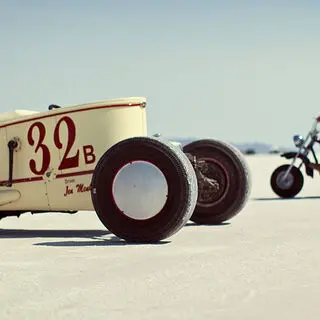
Saving Mother Nature's Peculiar Gift to Motorcar Racing
It may look like a giant skating rink or frozen lake from afar, but nature made the Bonneville Salt Flats not for ice skating or hockey, but for speed racing.
Located just two hours west of Salt Lake City, the Bonneville Salt Flats are truly a miracle of nature. Formed more than 14,000 years ago, they are a salt pan, or a large, crusty layer of salt and other minerals located in what used to be Lake Bonneville. This relatively rare type of landform arises when climate conditions cause water to evaporate at a faster rate than precipitation. When this water can’t drain back into a lake, it stays on the surface until it evaporates, and all the mineral content stays on the surface.
Originally called “Salduro Marsh” (sal duro means “hard salt” in Spanish), the salt pan was eventually renamed after Benjamin Bonneville, who explored the region in the 1830s.
The salt pan quickly began to be exploited by humans. As early as 1907, mining for potash and other minerals began. Additionally, people saw that the Bonneville Salt Flats’ unique properties made it a perfect place for moving fast. In 1896, Bill Rishel crossed the salt flats on his bicycle as part of a transcontinental race, and enthusiastically called them “the greatest speedway on earth.” In 1914, racecar driver Teddy Tetzlaff sped across the salt flats, setting the world’s land speed record for the time.

photo by: Tom Kelly/Flickr/CC BY-NC ND 2.0
Salt flats are formed when the rate of evaporation is faster than that of precipitation, leaving minerals to deposit as water evaporates.
The smooth salt (flat surfaces stretching for miles make it possible to decelerate after reaching high speeds; some racers reach up to 600 miles per hour!) and cool surface that didn’t overheat tires made “the Salt,” as speed racing fans affectionately call it, a perfect 11-mile speedway. Each year, Speed Week in August, World of Speed in September, and the World Finals in October attract speed racing fans to watch cars, motorcycles, and trucks break records.
Additionally the Bonneville Salt Flats have become an iconic Utah site. Thus it can be seen in many Utah-set films, such as The World’s Fastest Indian, in which Anthony Hopkins plays speed bike racer Burt Munro, who races at the salt flats; or the classic indie flick SLC Punk!, which deals with young rebels trying to be punk rockers in 1980s Salt Lake City, one of America’s more conservative metropolises.
Last year, Speed Week was cancelled for the second year in a row. According to racers, decades of mineral extraction have depleted the salt flats. (The Bureau of Land Management, which has been responsible for overseeing the site, claims that the causes of this are more than weather and mining and are not entirely understood.)
Whatever the cause, the Bonneville Salt Flats were once five feet thick, but now are just a few inches thick. According to the U.S. Geological Survey, Bonneville on average loses 1.1 percent of its salt surface each year. To make things worse, over the past two years mudslides resulting from heavy rains have made a significant part of the speedway’s surface brown with mud and unfit for racing.

photo by: Hatters!/Flickr/CC BY-NC 2.0
The Bonneville Salt Flats' smooth and cool surface make it a perfect place to reach shockingly fast speeds and decelerate fairly safely.
Recently, local preservationists have been taking ambitious steps to save the Bonneville Salt Flats, which have been on the National Register of Historic Places since 1975, where they are an “Area of Critical Environmental Concern.” The Save the Salt Coalition was formed in 1989 by racers, community leaders, and businesses to save the Bonneville Salt Flats, both as a great speedway and as a natural wonder.
These preservationists, who claim that the Bureau of Land Management has mismanaged the salt flats, recently received encouragement from Utah Governor Gary Herbert, who signed a resolution imploring the BLM to restore the site. However, the resolution didn’t provide funding or greater details.
Nonetheless, the governor’s motion was widely noticed in the Utah media and drew attention to the depletion of the Bonneville Salt Flats. Hopefully, greater awareness of the problem will put greater pressure on the BLM to act, and 2013 won’t be the last year that Speed Week was held.



